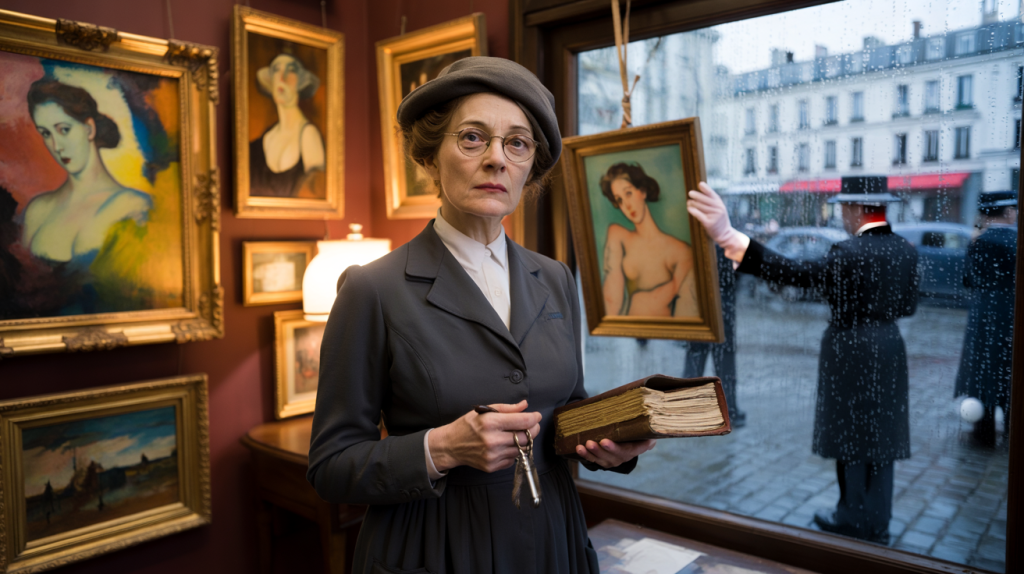Berthe Weill, Fearless Galeriste of Paris: The Woman Who Backed Picasso and Sparked Modigliani’s Scandal
Some names sit in bold on museum walls. Berthe Weill’s often does not. Yet this Paris galeriste, born in 1865 and gone in 1951, helped launch the very artists who defined modern art. Her gallery opened in 1901 in Paris and pushed early works by Pablo Picasso, Henri Matisse and Amedeo Modigliani into a wary market. One show even got shut down by the police. Yes, that happened.
The facts are stubborn. In 1917, Berthe Weill staged Amedeo Modigliani’s first solo exhibition in Paris. Police arrived on opening day and ordered the nudes removed from the storefront for indecency, forcing the gallery to close. Years earlier, she had been among the first dealers to champion the young Picasso in Paris and to hang canvases by the future Fauves. From start to finish, her story reads like the backstage script of modern art.
Who was Berthe Weill, galeriste of modern Paris
Here is the starting line. Berthe Weill grew up in a modest Jewish family, learned the trade in the city’s art market, then opened Galerie B. Weill in 1901. Paris was exploding with ideas, but money was cautious and reputations were fragile. She bet on artists before the labels existed and kept the door open to visitors who could not afford a centime.
The problem that still lingers today is visibility. Museum labels highlight big male dealers, while Weill’s name stays small. Yet her choices shaped careers. She exhibited Henri Matisse in the first decade of the century, supported Raoul Dufy and Kees van Dongen, showed Marie Laurencin and Suzanne Valadon when women artists faced closed doors. The path was narrow, but she walked it anyway.
And the timeline is clear. She worked continuously through the 1900s and 1910s, published sharp, funny memoirs in 1933 titled “Pan! Dans l’œil! ou trente ans dans les coulisses de la peinture contemporaine 1900-1930”, then had to close the gallery in 1941 under the Occupation. She died in 1951 with too little credit for too much courage.
From 1901 to 1941 : backing Picasso, Matisse and a market not ready
Early modern art needed believers who could sell before critics agreed. Weill did the legwork. She bought small, sold small, and kept cash moving for artists who were not yet market darlings. Collectors hesitated. Prices were low. Still, she placed works and introduced names that would later look inevitable.
One common mistake today is to read the period through Ambroise Vollard or Daniel-Henry Kahnweiler and forget the ecosystem. Weill dealt with the same generation, often earlier and with fewer resources. The 1901 launch date matters: it positions her at the exact moment Picasso’s Paris story began and right as the Fauves were sharpening their colors. She did not wait for safety. She tested instinct against rent due at the end of the month. Definitley not the easy route.
The 1917 Modigliani episode still shocks. Police shut the show for indecency when nudes were visible from the street window. The intervention froze sales and left the artist and dealer exposed. That disruption, recorded in Paris police annals and retold in exhibition catalogs, captures how far ahead she operated. Not just taste. Nerve.
Reappraisals : exhibitions and records put Berthe Weill back in view
Recent scholarship has begun to catch up. From June to November 2022, the Musée d’Art et d’Histoire du Judaïsme in Paris presented a major exhibition dedicated to Berthe Weill, tracing her network, correspondence and sales. The dates matter because they mark an institutional return to sources: letters, account books, press clippings, and the 1933 memoir.
That renewed attention helps correct a blind spot. It also clarifies who did what, when. Weill’s early involvement with Picasso appears in dealer records and period newspapers from the 1900s. Her support for Marie Laurencin and Suzanne Valadon is documented in exhibition listings. The gallery’s 1941 closure is tied to wartime measures that squeezed Jewish professionals and the art trade at large. These are not legends. They are documented steps.
And there is a practical upside. With archives surfacing and catalogs published, provenance lines tighten and display texts can finally name her contribution alongside the artists she backed. That small change shifts how audiences read a wall of works from 1900 to 1930.
Explore Berthe Weill today : books, archives, exhibitions
For readers, students, and curious museum-goers, the trail is alive and usable. The following resources give concrete ways to go further without getting lost.
- Her 1933 memoir “Pan! Dans l’œil! ou trente ans dans les coulisses de la peinture contemporaine 1900-1930” : first-hand, brisk and unfiltered.
- Exhibition catalogs from Paris shows in 2022 dedicated to Berthe Weill : timelines, documents, and images from the gallery years.
- Digitized press from 1901 to 1917 in French newspaper archives : exhibition announcements and sales notices.
- Museum labels for Picasso, Matisse, Modigliani, Laurencin and Valadon : look for early Paris provenance tied to Galerie B. Weill.
The larger picture lands with precision. From 1901 until the forced closure in 1941, Berthe Weill operated a small, agile gallery that helped modern art reach daylight. In 1917, the police closure of Modigliani’s show crystallized the stakes. In 1933, the memoir fixed her voice in print. In 1951, she passed away, still waiting for the credit now finally arriving.
